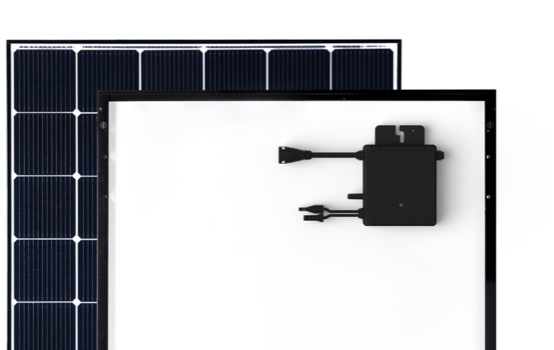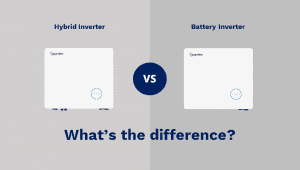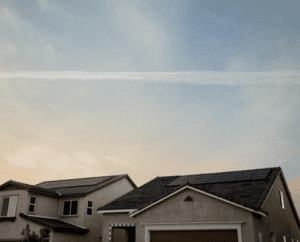What is the difference between Microinverters and Inverters?
When sunlight hits your solar panels, they create Direct Current (DC) electricity. But most homes use Alternating Current (AC), which is more efficient and easier to send over longer distances.
To work in your home and power your appliances, DC needs to be turned into AC. That’s where an inverter comes in.
WHAT IS AN INVERTER?
The process of converting Direct Current (DC) power to Alternating Current (AC) power for safe use is called inversion. The technology that makes this possible is an inverter.
Types of inverters
There are several types of inverters that you may encounter: central inverters, string inverters and microinverters.
Central inverters
These are used in massive ground solar stations with output over 500kW. In larger installations, they are above ground.
| Advantages | Disadvantages |
|---|---|
| ● Ideal for large-scale implementations | ● Rigorous requirements for installation locations |
| ● Huge output capacity | ● A single point of failure for the entire system |
String inverters
Solar panels are usually installed in strings – a series of panels connected together. Using string inverters, each set of panels gets its own inverter. Often, string inverters can use Maximum Power Point Tracking (MPPT) to constantly measure how panels are performing and adjust production depending on these conditions.
| Advantages | Disadvantages |
|---|---|
| ● Cheaper than microinverters | ● Power production limited to your worst-performing panel |
| ● Only one required for a small installation | ● Maximum Power Point Tracking (MPPT) is shared across 1-4 strings of panels |
| ● If a string inverter fails, the entire row stops producing |
Microinverters
Microinverters work similarly to string inverters and offer the same key benefits. However, they can often be installed directly under your solar panels, converting power from just one to four panels at a time.
| Advantages | Disadvantages |
|---|---|
| ● Small size and simple installation | ● More expensive than string inverters |
| ● No single point of failure for your system | |
| ● Can be installed where space is limited | |
| ● Options to monitor performance of individual panels |
WHY SOME SOLAR PANELS LIMIT YOUR INSTALLATION
The process of converting Direct Current (DC) power to Alternating Current (AC) power for safe use is called inversion. The technology that makes this possible is an inverter.
These include:
- Shade caused by trees, buildings, or other rooftop structures
- Soiling including dust, snow, or bird droppings
- Panel faults like micro cracking, hot spots, water ingress, or manufacturing issues
- Temperature fluctuations at different times of the day
- Aged panels with performance degradation
- Poor panel mounting or complex roof layouts
- Smaller roofs with only a limited number of panels
- Inconsistency between modules and brands in terms of output and performance over time
In a standard string installation, your panels are linked together in series. If one of your panels doesn’t perform, the entire installation is affected.
Microinverters let you monitor and optimize each individual panel, generating the maximum power.
UNDERSTANDING INVERTER EFFICIENCY CURVES
The efficiency of an inverter is usually expressed in terms of a curve. You will see these when comparing inverter performance on various manufacturer websites and resources, including Hoymiles. However, it can be difficult to interpret efficiency curves to make informed decisions about your installation.
The traits of a good efficiency curve
The efficiency of an inverter is usually expressed in terms of a curve. You will see these when comparing inverter performance on various manufacturer websites and resources, including Hoymiles. However, it can be difficult to interpret efficiency curves to make informed decisions about your installation.
Above all else, a good efficiency curve should reflect consistent performance in a wide range of conditions and light levels.
Generally, efficient inverters:
- Create curves that rise quickly, denoting good low light performance
- Create flat curves with no obvious dropping phenomenon
- Offer high performance under full load (at the right end of the curve)
- Show overlapping curves at different voltages
In practice, a weighted efficiency rating can be a more reliable overview of performance than a curve. They measure performance across the full capacity of your inverter.
Hoymiles weighted efficiency rating
CEC peak efficiency 96.7%

THE TWO FACTORS THAT AFFECT SOLAR POWER GENERATION
Your solar panels and microinverters aren’t the only factors that affect performance. Maximizing your power generation takes quality and careful planning throughout your installation.
The realities of solar irradiation
Solar panels need to be properly irradiated – exposed to the beams of radiation that come from the sun.
Positioning your panels is an important part of this process. However, irradiation levels can also be affected by:
- Air quality
- Dust
- The actual temperature or environmental temperature of your solar panels
- The actual efficiency or attenuation of your modules
The potential of your solar ecosystem
Beyond your solar panels, the rest of your installation may limit your power production.
Common issues that affect output include:
- Power loss through your cables
- The efficiency and reliability of your inverters
- Mismatch loss and MPPT efficiency
- The on-line rate of your system
THE IMPORTANCE OF MATCHING SOLAR PANELS TO INVERTERS
Maximizing the performance of your installation means effectively matching the right inverters to your solar panels, considering capacity, power production and load handling.
The risk of mismatching
If your inverters aren’t appropriately matched to your solar panels and their production, the consequences can be significant. You may cause permanent damage to your inverters, or significantly impact your power generation.
Recommended ratios
We recommend that the matching ratio doesn’t exceed more than 1.35 times your installed capacity. This will help increase the cost-effectiveness of your inverters, deliver consistent power, and maximize performance.
WHY IS A MICROINVERTER THE BEST CHOICE?
As a home user, microinverters are the best choice due to their small size and efficiency. They bring resilience to your installation while giving you increased control and flexibility.
Microinverters make for an easier and more efficient installation
With a string inverter, solar panels need to be installed in series, then connected to a string inverter at the end. This limits the electricity production of each panel to the lowest producing panel on your roof.
Microinverters are installed in a parallel circuit. This means each panel is directly connected to a microinverter. Depending on your microinverter model, you can connect up to six panels to a single microinverter.
As a result, a microinverter can take full advantage of the production of each individual panel. Each solar panel and microinverter combination can perform at its best, producing more power.




